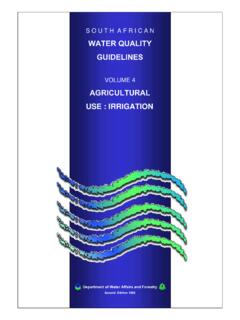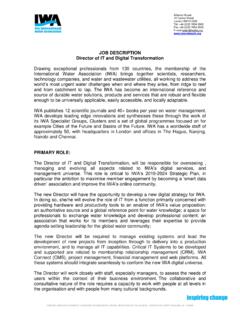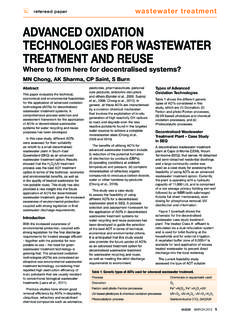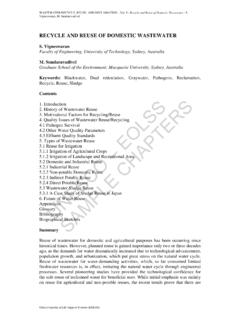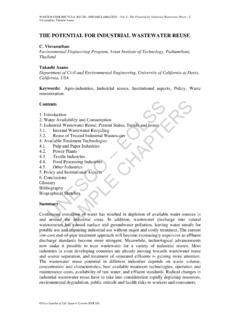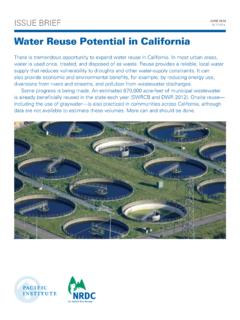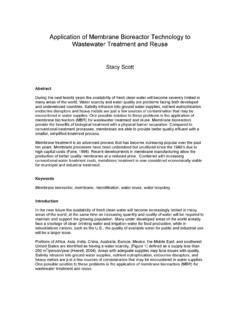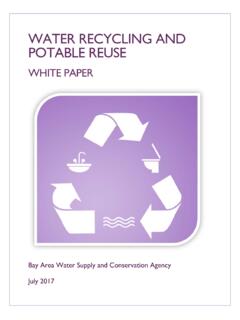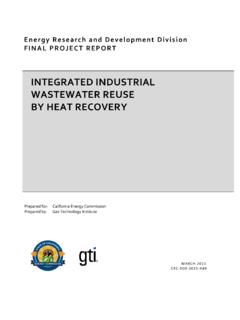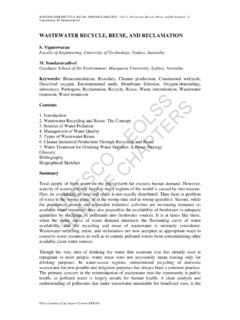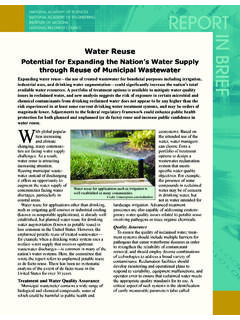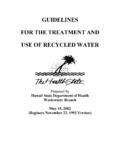Transcription of China Reclaimed Water Reuse Regulations
1 1 China Reclaimed Water Reuse Regulations By S as ha Ro dr igu es ( I W A); An n ex by Xu ju n Liu ( Yu nn an W at er I n du st r y I n vest m en t an d Develo pm en t C o , Lt d.). Abstract China faces serious Water quality and availability challenges due to rapid urbanization, popu-lation growth and climate change. Six national technical standards on wastewater Reuse were established between 2002 and 2005 which allowed for the development of an effective Reclaimed Water system nationwide, resulting in the improvement of the reliability and per-formance of municipal wastewater treatment processes (Yi et al.)
2 , 2011). To maintain and continue Water quality improvement there needs to be capacity development, integrated Water resources management and the development of financing instruments. ContextChina faces serious Water quality and availability issues due to rapid urbanization, population growth and climate change. A recent national environment bulletin showed that only of rivers, of lakes and reservoirs and of groundwater wells met the Water quality cri-teria for source Water supply (MEP, 2014). China ranks 6thin the world for total Water resources even though its annual per capita freshwater availability is only 2300m3, which is a quarter of the global average (Cheng et al.
3 , 2009). One way to reduce Water stress is through wastewater reclamation and Reuse . Currently, this is not a popular option as Water Reuse is still far below the total production of municipal wastewater (Table 1). However, recent policy changes have demonstrated opportunities for developing mu-nicipal wastewater reclamation projects and their capacity to alleviate the pressure on Water resources which need to supply multiple users ( industry, urban, irrigation and environ-ment). Table 1: China s Water availability and Reuse potential Total annual average Water resources trillion m3 / year (ranked 6thin the world) Renewable freshwater availability 2300 m3 per capita/year (25% of the global average) Total Municipal wastewater billion m3 / year wastewater Reclaimed 976 million m3/year (4%) Source: Cheng et al.
4 (2009) Analysis Perceiving China s potential for wastewater re-use as a means of Water stress alleviation, the Ministry of Construction launched a series of projects in 1985 to improve national Water pollu-tion control measures in cities in northern China , including Tianjin, Tai an, Xi an and Taiyuan. These projects greatly enhanced the develop-ment of wastewater reclamation technology in China . This process provided an approach for other cities developing their own municipal 2 wastewater reclamation systems to deal with increasing Water scarcity and demand.
5 To implement the national urban wastewater Reuse plans, six national technical standards on wastewater Reuse were established between 2002 and 2005, including Regulations and criteria for industrial, urban, environmental and irriga-tion uses. These provisions, in addition to those aimed at ensuring efficient treatment systems, allowed for the development of effective re-claimed Water systems nationwide and improved the reliability and performance of municipal wastewater treatment processes (Yi et al.)
6 , 2011). Standards are presented and described in detail in the annex. In 2006, the National Development and Reform Commission, the Ministry of Construction and the Environmental Protection Agency jointly developed the National Urban Sewage Treat-ment and recycling Facilities Plan in an effort to direct local entities towards the expansion of Reclaimed wastewater uses. The combined ac-tions of these plans and the six national stand-ards resulted in the development of detailed Water quality standards and are expected to increase China s wastewater reclamation capaci-ty by million m3 per day.
7 In 2012, the State Council issued the 12th Five-Year Plan for Construction of Municipal wastewater Treatment Facilities and wastewater Reclamation Facilities. According to this plan, the wastewater reclamation rate should reach 15% by the end of 2015 (State Council, 2012). Lessons Learned The Regulations set up by the Chinese govern-ment have established detailed Water quality standards and Water use instructions regulating the quality of Reclaimed Water being used in the country.
8 Supporting policies on the establish-ment of treatment plants and the promotion of the expansion of Reclaimed Water uses aimed to motivate local entities and regulators to use Reclaimed wastewater . As a result, China s Water infrastructure is improving. By 2010, China in-creased its municipal wastewater treatment rate to 75% and Beijing built an 8,000 m3/day Water reclamation facility to supply Water for road washing, toilet flushing, and other non-potable uses (Da Silva et al., 2012).
9 However, while the Regulations are a promising step towards better management of the Water needs of different users, there are still a number of aspects which must be considered in more detail. One example is the need for a detailed master plan for wastewater reclamation on a for each city. As it stands, the demand for Reclaimed Water is low and only 4% of the billion m3 of dis-charged municipal wastewater is Reclaimed (Cheng et al., 2009). Few public awareness and education programmes have been organised to promote the use of Reclaimed Water , and conse-quently public acceptance is low, which limits the effectiveness of the policy measures (Yi et al.)
10 , 2011). Furthermore, uniform implementation and enforcement remain elusive and cities which do not experience Water shortages regularly still rely on inter-basin Water transfers (MWR, 2007; Yi et al., 2011). Water resource management in China is shared amongst various agencies and levels of govern-ment including State and Provincial environmen-tal protection bureaus, the Ministry of Water Resources, the Ministry of Construction and the Ministry of Land and Resources (Cheng et al., 2009). Although each governmental level has policies regulating different aspects of Water shortage management, these policies do not work together on multiple scales.


